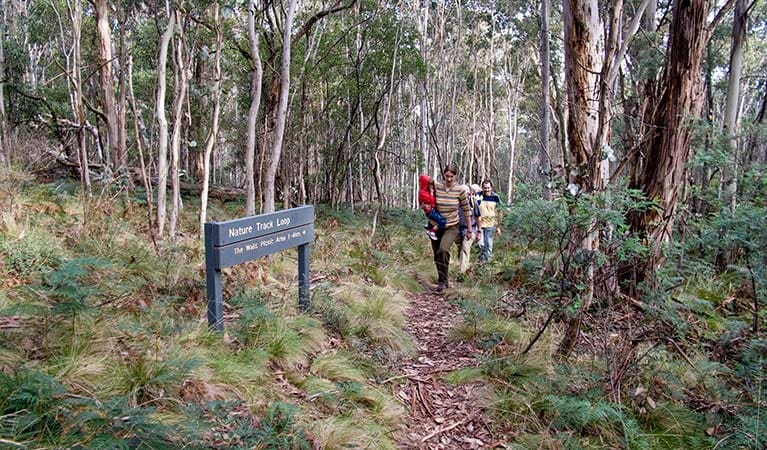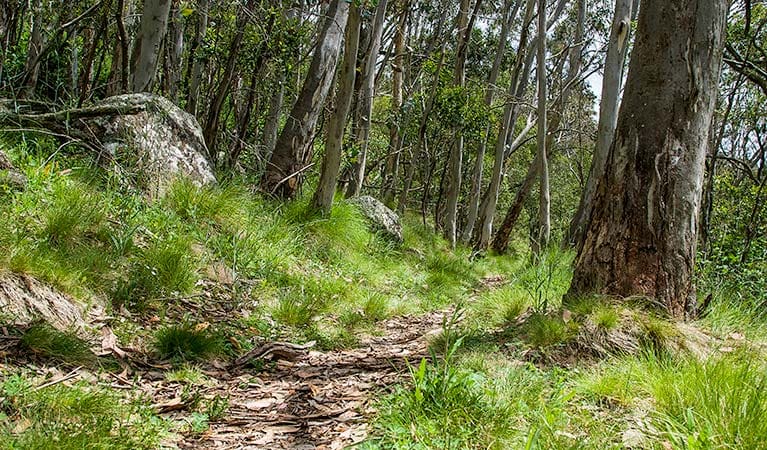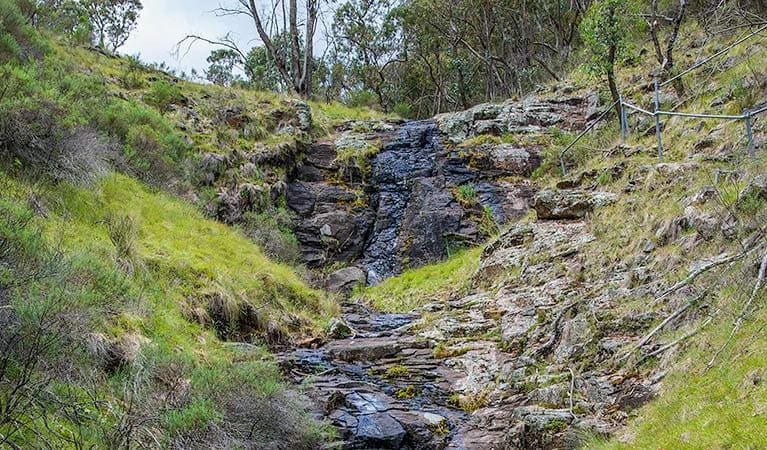Hike at a Glance
Max elevation: 0m
Min elevation: 0m
Total Ascent: 0m
Hike overview
Summits walking track connects two of the park's summits, Mount Canobolas (also known as Old Man Canobolas) and Young Man Canobolas, traversing a saddle between to two mountains and joining up with some of the other walking tracks along the way.
Before you head off on the walk, take some time to admire the scenic view from the summit of Old Man Canobolas; you'll be able to see the town of Orange and surrounding countryside.
When you're on your way, you'll first hike along a downhill track that passes through snowgum grassy woodland. Keep an eye out for grey currawongs during summer and look for white throated tree creepers. From there, you'll wind uphill to the summit of Young Man Canobolas.
If you'd like to turn this short walk into a longer day walk, you can join up with the Spring Glade, Snowgum or Nature tracks; look out for signage along the way.
Tips
Because of the altitude, the weather can change quite quickly. You should always check the weather forecast before setting out for a walk. It's advisable to bring a jumper with you, and in winter always bring a raincoat and warm clothing.
Spring Glade, Snowgum and Nature walking tracks connect with Summits walking track - look for signage along the way
Remember to take your binoculars if you want to bird watch
Visit NSW National Parks and Wildlife Service for more information on this trail.
The longitude and latitude of the start and end points are approximately only and should not be used for navigation purposes. Please contact me if you know the correct coordinates.
Gallery
Got some great shots from this hike? Upload your photos here to inspire others and show off the beauty of the trail!
Uploading your photos doesn’t mean you lose ownership. You can be credited for your contributions, and you can request removal at any time.
Content use
Please don’t copy GPX files or content from this site to AllTrails or other platforms. Each trail has been personally mapped, documented, and refined to support Australia’s bushwalking and hiking community. While some details come from land managers, every listing reflects significant personal effort. This is a free, community-driven initiative—your respect helps keep it that way.
Walk map and GPX file
It looks like I don’t have a GPX file for this trail yet. If you have one to share, please email it to me! I’ll verify it against official maps before adding it to help other hikers have a safer, easier experience. Thanks for contributing to a better hiking resource.
Getting there
Getting to the trailhead: Mount Canobolas State Conservation Area.
On entering Mount Canobolas State Conservation Area, follow Mount Canobolas Road all the way to the summit of Mount Canobolas. Road quality Roads may close when it snows (generally once or twice each winter).
Closest towns to this walk: Blayney, Bloomfield, Borenore, Cadia, Manildra, Millthorpe, Molong, Nashdale, Orange, Spring Hill
About the region
Mount Canobolas State Conservation Area offers birdwatching, walking, scenic views, pretty picnic areas and a great campground; a top choice for a weekend getaway. The majestic Mount Canobolas is a dormant volcano that formed millions of years ago when Australia was sitting over a hotspot in the earth's crust. It is part of the Brigooda-Oberon chain that stretches 800km from southeast Queensland to near Oberon in NSW and last erupted eleven million years ago, spewing lava from the main vent and up to 30 vents in the surrounding area. With its rich soil, high altitude and cool climate, it's the perfect environment for a range of plants and animals. There are great places to picnic and a number of walking tracks, plus the park is only a short drive from Orange so it makes for a great daytrip. If you feel like a weekend getaway, there's also a campground that offers basic facilities in a pretty setting, right near the start of the Federal Falls walking track.
Similar walks nearby
Looking for more walks in or near Mount Canobolas State Conservation Area? Try these trails with a similar difficulty grade.
Track grade
Grade 3 (Moderate) - Walks for Most Fitness Levels: Grade 3 on the AWTGS represents moderate walking tracks. These are ideal for walkers with some fitness who are comfortable with some hills and uneven terrain. While suitable for most ages, some bushwalking experience is recommended to ensure a safe and enjoyable experience. Tracks may have short, steep hill sections, a rough surface, and many steps. The total distance of a Grade 3 walk can be up to 20 kilometers.
Explore safe
Plan ahead and hike safely! Carry enough water, pack layers for changing conditions, and bring safety gear like a torch, PLB, and reliable communication device. Check official sources for trail updates, closures, and access requirements, and review local weather and bushfire advice. Most importantly, share your plans with someone before you go. Being prepared makes for a safer and more enjoyable hike! Stay Safe, Explore More, and Always #ExploreSafe.
Packing checklists
What you carry in your pack depends on factors like weather, terrain, and your adventure type. Not sure what to bring? My free planning, food, and packing checklists are a great starting point, covering day hikes, overnight trips, and multi-day adventures. Use them to customise your kit and always prioritise safety.
Let someone know
Before heading out, take a moment to fill out your trip intentions form. It’s a quick way to share your hike details with family or friends. If something goes wrong, they can notify emergency services, ensuring a faster response and peace of mind. Stay safe and enjoy your adventure
Suggest an edit
Spotted a change on this trail? Maybe there are new features, the route has shifted, or the trail is permanently closed. Whatever the update, I’d love your input. Your feedback helps fellow hikers stay informed and ensures that our trail info stays fresh and reliable.
Acknowledgement of Country
Trail Hiking Australia acknowledges the Traditional Owners of the lands on which we hike and pay respects to their Elders, past and present, and we acknowledge the First Nations people of other communities who may be here today.






